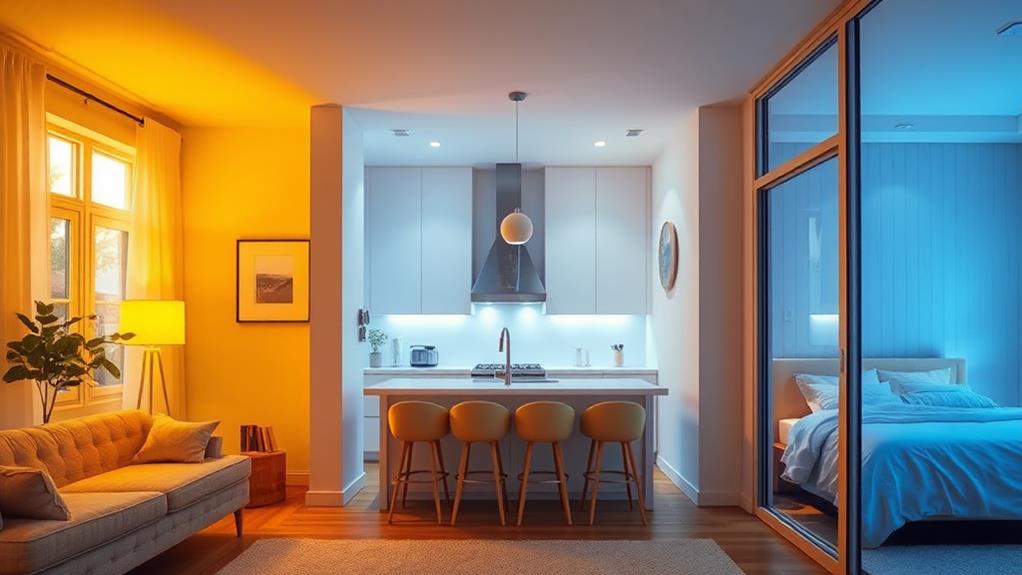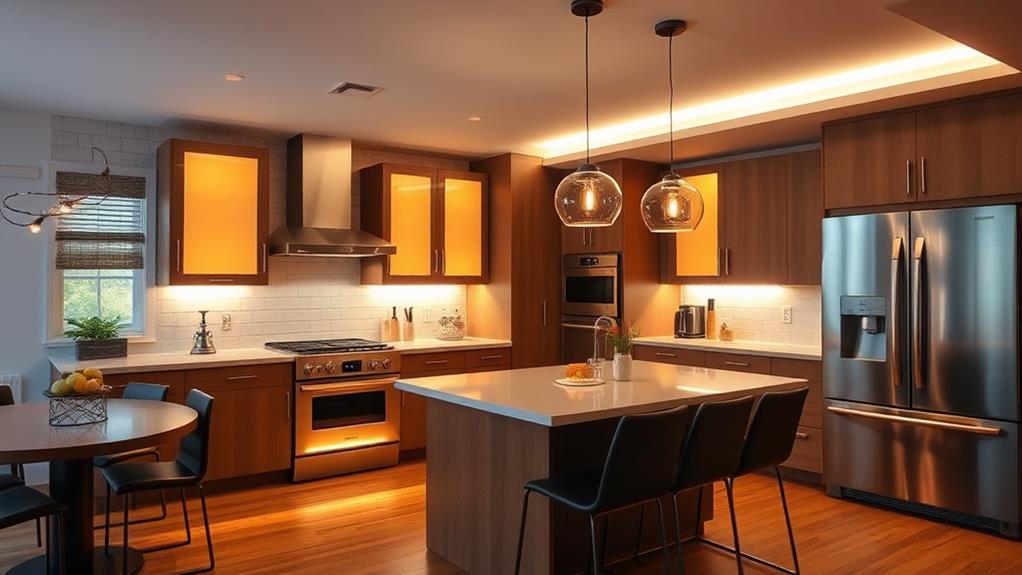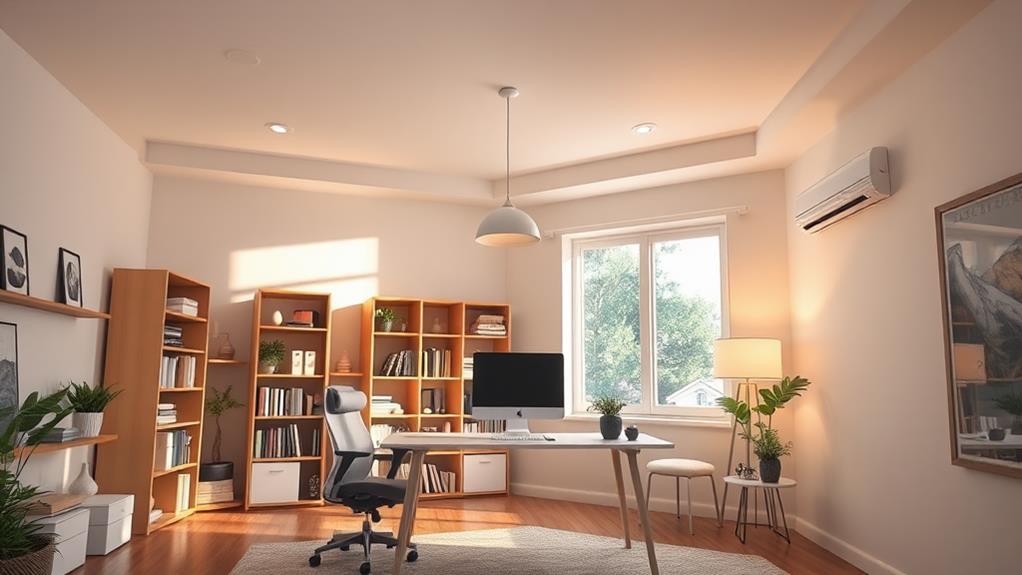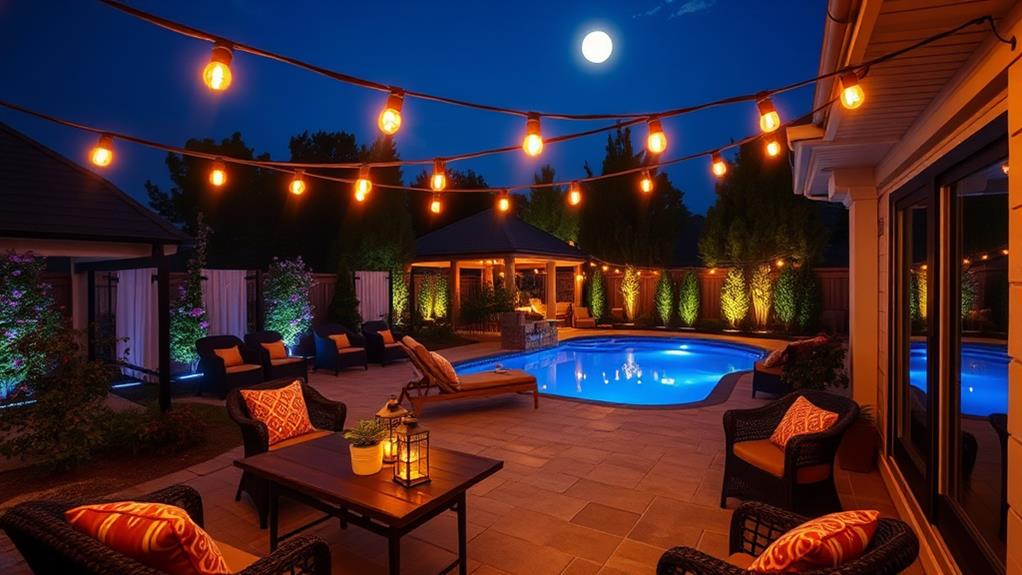When choosing color temperatures for different rooms, consider the space's function and desired atmosphere. For living rooms, opt for warm whites (2700K-3000K) to create a cozy ambiance. In kitchens, use cooler temperatures (3000K-4000K) for better visibility. Bedrooms benefit from warm tones (2700K-3000K) to promote relaxation. Home offices work well with daylight-mimicking temperatures (4000K-5000K) for improved focus. In bathrooms, mix cooler ambient lighting (3000K-4000K) with warmer task lighting (2700K-3000K). For outdoor spaces, combine warm and cool temperatures to enhance security and aesthetics. By understanding these principles, you'll be well-equipped to create the perfect lighting environment throughout your home.
Understanding Color Temperature

When you walk into a room, the lighting sets the mood. The color temperature of your light sources plays a crucial role in creating the right atmosphere. Measured in Kelvins (K), color temperature describes the appearance of light, ranging from warm to cool tones.
Lower color temperatures (2700K-3000K) emit a warm, yellowish light resembling candlelight or sunset. These create a cozy, intimate ambiance ideal for relaxation.
Mid-range temperatures (3500K-4100K) produce a neutral white light, balancing warm and cool tones. This versatile option works well in multi-purpose spaces.
Higher color temperatures (5000K-6500K) generate a cool, bluish-white light similar to daylight. They're energizing and great for task-oriented areas. To understand color temperature visually, picture a flame: as it gets hotter, its color shifts from red to blue.
When choosing bulbs, you'll often see terms like "warm white," "cool white," or "daylight." These correspond to different color temperature ranges. LED bulbs offer the widest variety of color temperatures, allowing you to fine-tune your lighting. By selecting the appropriate color temperature for each room, you'll enhance its functionality and create the desired atmosphere.
Living Room Lighting
Living rooms often serve multiple purposes, from relaxation to entertainment. When choosing the right color temperature for your living room lighting, you'll want to strike a balance that accommodates these various activities.
For general use, aim for a warm white light in the range of 2700K to 3000K. This creates a cozy, inviting atmosphere that's perfect for unwinding after a long day. It's also ideal for socializing, as it flatters skin tones and makes people feel comfortable.
If your living room doubles as a home theater, consider installing dimmable lights. This allows you to lower the brightness for movie nights while maintaining the warm color temperature. For reading nooks or areas where you need more focused light, you might add task lighting with a slightly cooler temperature of 3000K to 3500K.
For larger living rooms or those with high ceilings, you can mix different color temperatures to create depth and visual interest. Use warmer lights for ambient lighting and slightly cooler temperatures for accent lighting on artwork or architectural features. This layered approach will enhance the room's overall ambiance and functionality, ensuring your living space is both welcoming and versatile.
Kitchen and Dining Areas

Moving from the cozy atmosphere of the living room, let's explore the lighting needs of kitchen and dining areas. These spaces require a balance between functionality and ambiance, as they serve both practical and social purposes.
For kitchens, opt for cooler color temperatures between 3000K and 4000K. This range provides crisp, clean light that enhances visibility for food preparation and cooking tasks. It also helps you distinguish between different colors, which is crucial when checking food doneness or identifying ingredients.
In dining areas, you'll want to create a warm, inviting atmosphere. Choose color temperatures between 2700K and 3000K, which emit a soft, golden glow reminiscent of candlelight. This range flatters skin tones and food presentations, making meals more appealing.
Consider using dimmable lights in both areas to adjust the brightness throughout the day. For instance, you might prefer brighter light for breakfast and food prep, but softer illumination for dinner parties. Layer your lighting with a combination of overhead fixtures, under-cabinet lights, and pendant lamps to create a versatile and well-lit space that adapts to various activities and moods.
Bedroom Color Temperature
As we tuck into the topic of bedroom lighting, it's important to consider the room's primary function: rest and relaxation. The color temperature you choose can significantly impact your sleep quality and overall comfort in this space.
For bedrooms, you'll want to opt for warmer color temperatures, typically between 2700K and 3000K. These soft, amber hues mimic the natural light of sunset and promote the production of melatonin, the hormone responsible for regulating sleep cycles. You'll find that this warm lighting creates a cozy, inviting atmosphere that helps you unwind after a long day.
Consider installing dimmer switches to adjust the light intensity as needed. This allows you to create a brighter environment for activities like reading or getting dressed, while still maintaining the ability to lower the light levels for a more soothing ambiance before bedtime.
Don't forget about task lighting, such as bedside lamps or wall sconces. These should also feature warm color temperatures to maintain consistency throughout the room. By carefully selecting the right color temperature for your bedroom, you'll create a tranquil sanctuary that promotes restful sleep and relaxation.
Home Office Illumination

While bedrooms call for warm, soothing light, home offices require a different approach. You'll want to create an environment that promotes focus, productivity, and alertness. For this reason, cooler color temperatures are often the best choice for your home office illumination.
Aim for a color temperature between 4000K and 5000K, which mimics natural daylight. This range helps reduce eye strain and fatigue, especially when you're working long hours or staring at screens. It's also been shown to improve concentration and cognitive performance.
Consider using adjustable LED lights that allow you to change the color temperature throughout the day. Start with cooler temperatures in the morning to boost alertness, and gradually shift to warmer tones as the day progresses. This can help maintain your circadian rhythm and improve sleep quality.
Don't forget task lighting. Desk lamps with cooler color temperatures can provide focused illumination for detailed work. Ensure your lighting setup minimizes glare on screens and reduces shadows on your work surface.
Bathroom Lighting Considerations
Bathrooms present unique lighting challenges due to their multiple functions. You'll need lighting that's suitable for grooming tasks, relaxation, and safety. For the best results, aim for a layered lighting approach with different color temperatures.
For general ambient lighting, choose a cooler color temperature between 3000K and 4000K. This range provides crisp, clean light that's ideal for brightening the entire space. Install recessed ceiling lights or a central fixture for even illumination.
When it comes to task lighting around the mirror, opt for warmer temperatures between 2700K and 3000K. This range is flattering for skin tones and helps with accurate makeup application. Consider installing sconces on either side of the mirror or an illuminated mirror for optimal results.
For a relaxing atmosphere, incorporate some warm accent lighting at 2700K or lower. This can include dimmable wall sconces or even candles for a spa-like ambiance.
Don't forget about nighttime considerations. Install a motion-activated night light with a very warm color temperature (around 2000K) to provide safe navigation without disrupting your sleep cycle.
Outdoor Lighting Options

For outdoor lighting, you'll need to consider both functionality and aesthetics. When it comes to color temperature, cooler whites (4000K-6500K) are often preferred for security and task lighting. These temperatures provide better visibility and can deter potential intruders.
For pathway lighting, consider warmer temperatures (2700K-3000K) to create a welcoming atmosphere.
Landscape lighting offers an opportunity to highlight your home's architectural features and garden elements. Use a mix of color temperatures to create depth and interest. Warm white (2700K-3000K) works well for uplighting trees and shrubs, while cooler whites (4000K) can accentuate water features and stonework.
For patio and deck areas, aim for a cozy ambiance with warm white lighting (2700K-3000K). This temperature range is ideal for relaxation and socializing. If you frequently entertain outdoors, consider installing dimmable lights or smart bulbs that allow you to adjust the color temperature based on the occasion.
Don't forget about energy efficiency. LED bulbs are an excellent choice for outdoor lighting, as they consume less power and have a longer lifespan than traditional incandescent or halogen bulbs. They're also available in various color temperatures, making them versatile for different outdoor applications.
Conclusion
You've now got the keys to unlock the perfect ambiance in every room. Remember, color temperature isn't just about brightness—it's about creating the right mood and atmosphere. Whether you're cozying up in the living room or cooking up a storm in the kitchen, you'll be able to tailor your lighting to suit any activity. So go ahead, play with different temperatures, and watch your home transform before your eyes.

